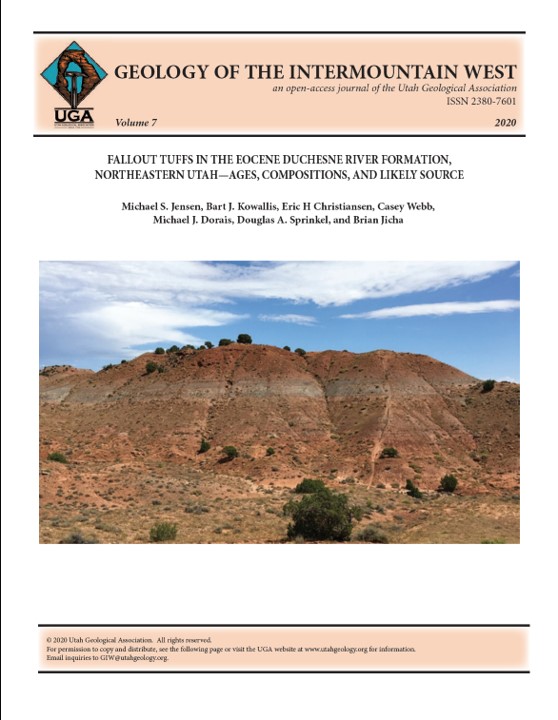Fallout tuffs in the Eocene Duchesne River Formation, northeastern Utah—ages, compositions, and likely source
Abstract
Thin fallout tuffs are common in the terrestrial deposits of the Eocene Duchesne River Formation on the flanks of the Uinta Mountains of eastern Utah. Their ages and compositions provide new insight into the tectonic events and magmatic history of the western Cordillera and provide important constraints on the Cenozoic land mammal chronology. Whole-rock compositions of the volcanic ash show that they underwent post-emplacement argillic alteration, typical of a wetland/floodplain depositional setting. However, immobile element ratios and abundances, such as Zr/Ti, La/Nb, and Y are typical of rhyolites formed in a subduction-related setting. Glass shards preserved in one sample all had SiO2 values >75%, typical of high-silica rhyolite. Preserved phenocrysts in the ash beds include quartz, sanidine, plagioclase, and biotite with variable amounts of accessory zircon, apatite, titanite, and allanite. Biotite compositions have Fe/(Fe+Mg) ratios typical of calc-alkaline igneous rocks and clusters of chemical compositions suggest a genetic relationship to three or four separate eruptions. Sanidine compositions from five samples range from Or73 and Or79. Only one sample had preserved plagioclase with compositions ranging between An22 – An49. Allanite from the ash beds has lower total rare earth elements (REE) concentrations than allanite from other well-studied rhyolites. Titanite in one sample has lower concentrations of REE, Fe, and Al than expected of rhyolites and is probably detrital.
Plagioclase and sanidine from two different tuff beds near the middle of the Duchesne River Formation yielded analytically indistinguishable 40Ar/39Ar ages of 39.47 ± 0.16 Ma and 39.36 ± 0.15 Ma, respectively. These dates, along with the compositional data seem to limit the eruptive source for these fallout tuffs to the northeast Nevada volcanic field, one of the few volcanically active regions of western North America at the time. These new radiometric ages, along with stratigraphic relations and previously published ages for tuffs in the Bishop Conglomerate (which unconformably overlies the Duchesne River Formation), constrain the timing of late Laramide uplift in the region from 39 to about 37 Ma and post-Laramide epeirogenic uplift from 34 Ma to 30 Ma. Finally, the ages also provide additional evidence that the Duchesnean North American Land Mammal Age ended in the Eocene, which was originally named and defined from the Duchesne River Formation.

Copyright (c) 2020 Utah Geological Association

This work is licensed under a Creative Commons Attribution 4.0 International License.




